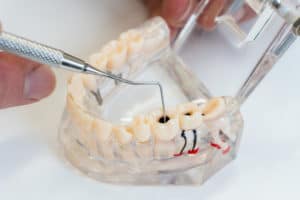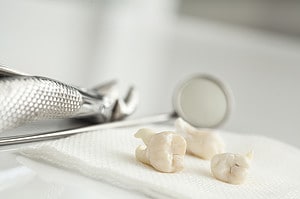As the sun sets on a beautiful summer day, a single bridge stands tall against the backdrop of the horizon.
This bridge, like a dental bridge, is a symbol of stability and strength. It carries the weight of countless travellers and provides a safe passage to their destination.
Similarly, a dental bridge is a dependable dental prosthetic device that can last for years with proper care and maintenance.
In this article, we will discuss the various factors that affect the longevity of a dental bridge and the steps you can take to ensure your dental bridge lasts as long as possible.
What is a Dental Bridge?
A dental bridge is a prosthetic device used to replace one or more missing teeth. It is a type of bridge that consists of one or more artificial teeth held in place by two dental crowns. Dental bridges are used to restore healthy teeth, as well as to provide a more aesthetically pleasing alternative to missing teeth.
The permanent bridge is typically anchored in place with dental crowns and connected to healthy teeth on either side of the gap. This helps to prevent the movement of teeth and tooth decay or gum disease. Dental bridges are a popular choice for many patients due to their convenience and durability.
With proper care and maintenance, a dental bridge can last for many years, providing a long-lasting and aesthetically pleasing solution to missing teeth.
What Materials Are Used for Dental Bridges?
Most commonly, dental bridges are constructed using materials such as porcelain, metal alloys, or a combination of both. These materials not only affect the overall cost of the dental bridge procedure but also the lifespan of the bridge. The type of bridge chosen will depend on the patient’s needs, budget, and the condition of the area they are replacing.
The most common materials used to create a dental bridge are:
- Porcelain, which is incredibly durable and can be colour-matched to the patient’s existing teeth.
- Metal alloys are the strongest option and are very cost-effective.
- Zirconia, which is a very strong and durable material that is aesthetically pleasing.
- Composite materials, which are a blend of metal and resin and can be used for more complex cases.
Overall, the choice of materials used for a dental bridge will ultimately be determined by the patient’s needs, budget, and the condition of the area they are replacing due to tooth loss.
Proper oral hygiene and routine maintenance are essential to ensure the longevity of the bridge, as any failure to care for the bridge properly can lead to premature failure. With the right care, a dental bridge can last anywhere from five to fifteen years, depending on the type of bridge chosen.
How Are Dental Bridges Attached?
Attachment of a dental bridge typically involves the use of dental cement to secure the bridge to adjacent teeth. This procedure requires the use of natural teeth, abutment teeth, or implants as anchors for the bridge. Depending on the structure of the bridge, it can be a traditional bridge, cantilever bridge, metal bridge, or resin-bonded bridge.
Traditional bridges involve the use of false teeth and are secured to adjacent teeth on both sides of the missing tooth or teeth. Cantilever bridges are used when there are only natural teeth on one side of the missing tooth or teeth. Metal bridges are a more durable option and involve the use of metal bands that are secured to adjacent teeth. Resin-bonded bridges are secured to adjacent teeth with a metal or porcelain framework and bonded with resin.
To ensure the longevity of the dental bridge, it is important to attend regular visits with your dentist for check-ups and maintenance. This will help maintain the health of the bridge, abutment teeth, and adjacent teeth. With proper care and maintenance, a dental bridge can last for many years.
How Long Do Dental Bridges Last?
The longevity of a dental bridge is dependent on regular maintenance and care. A temporary bridge, it is expected to last anywhere between one to three years, whereas a permanent bridge can last up to fifteen years or longer. Good oral hygiene practices, such as brushing and flossing, are key to maintaining the bridge. Additionally, avoiding sticky foods and practising proper care techniques are essential for maintaining a bridge’s longevity. Regular dental visits for professional cleanings and check-ups should also be included in the oral health regimen.
When cared for properly, a dental bridge can last for many years, just like real teeth. Proper dental care and treatment are key to ensuring the longevity of the bridge. Regular check-ups with a dentist and proper oral hygiene techniques are important for maintaining the bridge. Additionally, avoiding sticky foods and practising proper care techniques are essential for maintaining a bridge’s longevity.
With proper care, a dental bridge can last for many years and provide a natural and aesthetically pleasing smile.
What Factors Affect the Longevity of a Dental Bridge?
Proper care and maintenance are essential to preserving the longevity of a dental bridge. Oral hygiene habits, dental health, the type of material used, and root canals can all affect the average lifespan of a bridge.
Plastic teeth, ceramic bridges, and porcelain bridges are all commonly used for bridges on natural teeth. Implant-supported bridges use prosthetic teeth to replace lost teeth. To prepare the teeth adjacent to the bridge, some removal of tooth structure may be necessary, which can lead to tooth sensitivity.
An interdental brush can help to remove food debris from under the bridge, and soft foods should be consumed whenever possible.
Bridges on implants are also available as an alternative to dentures and can last up to 15 years with proper care and maintenance. This includes an oral care routine that should be followed daily, such as brushing and flossing thoroughly. Additionally, regular checkups with a dentist are essential in order to maintain good jaw health and the bridge itself.
Modern dentistry provides a solution for patients who are missing multiple teeth, and a dental restoration can last many years with the right oral hygiene routine. Ultimately, an improper bite can reduce the lifespan of a bridge, so regular checkups are key to preserving the bridge.
What Should You Do to Ensure Your Dental Bridge Lasts?
Having discussed factors that affect the longevity of a dental bridge, it is important to consider what action should be taken to ensure the dental bridge lasts a long time.
It is highly recommended that individuals get regular checkups and professional cleanings done on their dental bridges to ensure their function. In addition, if the bridge is not functioning properly, it is important to consult with a dentist to adjust or replace the bridge as soon as possible.
Dental implants can support dental bridges, which provide a secure hold and lasting solution to bridge replacement. Dental implant-supported bridges are the most secure and long-lasting option, as the bridge is fused to the implants, making it very difficult to dislodge.
It is also important to practice good oral hygiene and maintain a healthy diet to ensure the dental bridge functions properly and lasts a long time. Dental bridges can last anywhere from 5 to 15 years, depending on the quality of the bridge, the placement of the bridge, and the care given to the bridge. If the bridge is not properly placed or cared for, it can cause further damage and may need to be replaced sooner than expected.
What Are the Alternatives to a Dental Bridge?
Alternative treatments for replacing missing teeth include dental implants, partial dentures, and implant-supported dentures. A dental bridge is a great option for those who are looking to fill gaps in their teeth, but there are alternatives that may be a better fit for some.
Titanium posts are surgically inserted into the jawbone, and a replacement tooth is attached to the post. This option has several advantages, including minimizing bone loss and not requiring bone graft surgery. However, it is important to note that regular dental cleaning visits are necessary to prevent gum disease.
Partial dentures are another option for those looking to replace missing teeth. This option is a removable appliance that is made up of replacement teeth and clasps that attach to the existing teeth. This option is convenient, but it can lead to excess bonding cement or cement leakage, which can cause damage to the existing teeth.
Key Takeaways
A dental bridge is a long-term solution for replacing a missing tooth. It can give you the confidence back to show off your smile. With proper care and maintenance, a dental bridge can last for many years, allowing you to enjoy a natural-looking, healthy smile.
Although there are alternatives to a dental bridge, it is still the most popular choice for those looking to replace a missing tooth. With a little bit of effort and dedication, you can ensure that your dental bridge will be with you for years to come.
Like a bridge across a river, your dental bridge will provide a solid foundation for your smile.
If you are looking for a reliable and lasting solution to replace a missing tooth, come to Aspendale Gardens Dental Care in Aspendale Gardens, VIC. Our experienced and knowledgeable team of dentists will provide personalised service to ensure that your dental bridge fits your mouth comfortably and securely. With our professional care and maintenance, you can trust that your dental bridge will remain strong and dependable for many years to come.











